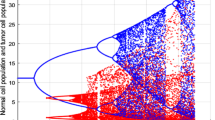Abstract
We present a model analysis of the tumor and normal cell growth under the influence of a carcinogenic agent, an immunomodulator (IM) and variable influx of immune cells including relevant interactions. The tumor growth is facilitated by carcinogens such as inorganic arsenic, while the IM considered here is black tea (Camellia sinesnsis). The model with variable influx of immune cells is observed to have considerable advantage over the constant influx model, and while the tumor cell population is greatly mitigated, normal cell population remains above healthy levels. The evolutions of normal and tumor cells are computed from the proposed model and their local stabilities are investigated analytically. Numerical simulations are performed to study the long-term dynamics and an estimation of the effects of various factors is made. This helps in developing a balanced strategy for tumor mitigation without the use of chemotherapeutic drugs that usually have strong side effects.








Similar content being viewed by others
Notes
We let \(N(t) (\equiv N)\) denote the number of normal cells at time t, \(T(t) (\equiv T)\) denote the number of tumor cells at time t, \(I(t) (\equiv I)\) denote the number of immune cells at time t, and \(s(t)(\equiv s)\) denote the variable influx of immune cells. \(A(t) (\equiv A)\) and \(D(t) (\equiv D)\) are the Arsenic and BT, respectively.
References
F. Bray, J. Ferlay, I. Soerjomataram, R.L. Siegel, L.A. Torre, A. Jemal, Global cancer statistics 2018: GLOBOCAN estimates of incidence and mortality worldwide for 36 cancers in 185 countries. CA Cancer J. Clin. 68(6), 394–424 (2018)
D. Sinha, S. Roy, M. Roy, Antioxidant potential of tea reduces arsenite induced oxidative stress in Swiss albino mice. Food Chem. Toxicol. 48(4), 1032–1039 (2010)
D. Sarkar, D. Rupali, Biogeochemistry of Arsenic in Contaminated Soils of Superfund Sites (United States Environmental Protection Agency, Washington, DC, 2007)
J. Carelton, Final Report: Biogeochemistry of Arsenic in Contaminated Soils of Superfund Sites (United States Environmental Protection Agency, Washington, DC, 2007)
D.N. Guha Mazumder, Diagnosis and treatment of chronic arsenic poisoning. United Nations synthesis report on arsenic in drinking water (2000)
H.M. Srivastava, U. Dey, A. Ghosh, J.P. Tripathi, S. Abbas, A. Taraphder, M. Roy, Growth of tumor due to arsenic and its mitigation by black tea in Swiss albino mice. Alex. Eng. J. 59(3), 1345–1357 (2020)
M.R. Haque, S.H. Ansari, Immunostimulatory effect of standardised alcoholic extract of green tea (Camellia sinensis l.) against cyclophosphamide-induced immunosuppression in murine model. Int. J. Green Pharm. (IJGP) 8(1), 52–57 (2014)
A. Gomes, P. Datta, A. Sarkar, S.C. Dasgupta, A. Gomes, Black tea (Camellia sinensis) extract as an immunomodulator against immunocompetent and immunodeficient experimental rodents. Orient. Pharm. Exp. Med. 14(1), 37–45 (2014)
C. Chattopadhyay, N. Chakrabarti, M. Chatterjee, S. Mukherjee, K. Sarkar, A.R. Chaudhuri, Black tea (Camellia sinensis) decoction shows immunomodulatory properties on an experimental animal model and in human peripheral mononuclear cells. Pharmacogn. Res. 4(1), 15 (2012)
L.G. De Pillis, A. Radunskaya, A mathematical tumor model with immune resistance and drug therapy: an optimal control approach. Comput. Math. Methods Med. 3(2), 79–100 (2001)
L.G. De Pillis, A. Radunskaya, The dynamics of an optimally controlled tumor model: a case study. Math. Comput. Modell. 37(11), 1221–1244 (2003)
J.C. Panetta, A mathematical model of periodically pulsed chemotherapy: tumor recurrence and metastasis in a competitive environment. Bull. Math. Biol. 58(3), 425–447 (1996)
S. Michelson, J.T. Leith, Host response in tumor growth and progression. Invasion Metastasis 16(4–5), 235–246 (1996)
V.A. Kuznetsov, I.A. Makalkin, M.A. Taylor, A.S. Perelson, Nonlinear dynamics of immunogenic tumors: parameter estimation and global bifurcation analysis. Bull. Math. Biol. 56(2), 295–321 (1994)
C. Castillo-Chavez, Z. Feng, W. Huang, On the computation of \(R_0\) and its role on global stability, in Mathematical Approaches for Emerging and Reemerging Infectious Diseases: An Introduction, edited book, vol. 1 (2002), p. 229
P. Van den Driessche, J. Watmough, Reproduction numbers and sub-threshold endemic equilibria for compartmental models of disease transmission. Math. Biosci. 180(1–2), 29–48 (2002)
A. Ghafari, N. Naserifar, Mathematical modeling and lyapunov-based drug administration in cancer chemotherapy. Iran. J. Electr. Electron. Eng. 5(3), 151–158 (2009)
X. Yang, L. Chen, J. Chen, Permanence and positive periodic solution for the single-species nonautonomous delay diffusive models. Comput. Math. Appl. 32(4), 109–116 (1996)
Y. Song, S. Yuan, Bifurcation analysis in a predator–prey system with time delay. Nonlinear Anal. Real World Appl. 7(2), 265–284 (2006)
Acknowledgements
The authors are thankful to the reviewers for their constructive comments, which helped in improving the manuscript.
Author information
Authors and Affiliations
Corresponding author
Rights and permissions
About this article
Cite this article
Kiran, R., Tyagi, S., Abbas, S. et al. Immunomodulatory role of black tea in the mitigation of cancer induced by inorganic arsenic. Eur. Phys. J. Plus 135, 735 (2020). https://doi.org/10.1140/epjp/s13360-020-00766-1
Received:
Accepted:
Published:
DOI: https://doi.org/10.1140/epjp/s13360-020-00766-1




